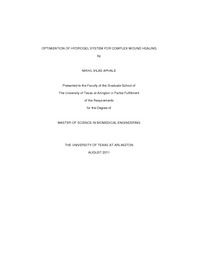| dc.description.abstract | Various conventional therapies and preventive measures have been developed and used for treating complex wounds; however, patients with complex wounds still develop wound infection and consist of delayed wound healing. These limitations necessitate the development of a novel therapeutic system, which is cost effective, easily apply onto the complex wounds, and consists of an efficient therapeutic nature. An in situ forming hydrogel system, made up of a novel biodegradable elastomer poly (ethylene glycol) maleate citrate (PEGMC), was designed and optimized for complex wound healing. Biocompatibility of this hydrogel system was studied by determining the toxicity of both the formation factors, including PEGMC monomers and APS initiator, and the effluents of the system on human dermal fibroblasts (HDFs). Cell viability was above 80% up to 5mg/ml for PEGMC, 50 µg/ml for APS, and 2.22mg/ml for the system effluents. Effects of the system formation factors on its properties, such as curing time, Young's modulus, swelling ratio, and degradation, were also investigated. Initiator APS and crosslinker PEGDA 700 concentration were the most affecting factors on the curing time in a negative manner. On other hand, crosslinker PEGDA 700 concentration positively affected the Young's modulus and negatively affected the swelling ratio of the system. The degradation of the system was observed to have an effect of different formation factors at different time points. To enhance the system performance for complex wound therapies, the optimized hydrogel system was also designed to have a dual layer for sustained drug release by controlling degradation properties of each layer and to consist of bactericidal property by incorporating antibacterial peptides (CHRG01, Abu-CHRG01). Results from this research project demonstrated that the developed novel hydrogel system could be cost effective and easy to apply onto wounds of any shape and size as well as useful for providing a sustained release of a therapeutic reagent in controlled fashion, and could fight with the bacterial infection. | en_US |

